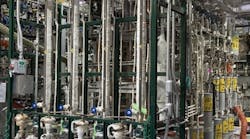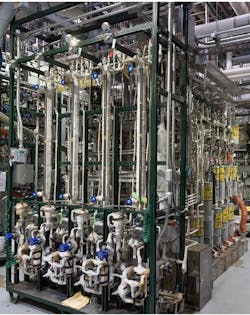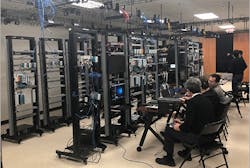Process Control: Open Automation Passes Key Tests
ExxonMobil originally started discussing what has become Open Process Automation (OPA) in 2010. The end of life for a significant amount of legacy automation systems in the marketplace had resulted in myriad migration projects that yielded an updated set of systems at a very high cost and with little benefit beyond temporarily mitigating obsolescence. After evaluating the situation, considering possible solutions, and creating a vision for the future of automation, ExxonMobil began sharing that vision of what OPA might look like along with advocating for inserting the appropriate information technology (IT) into our operational technology world. In early 2016, ExxonMobil began to put action to the words with a development collaboration with Lockheed Martin and, then, in late 2016, by joining with other like-minded companies to form the Open Process Automation Forum (OPAF), within the Open Group. Since its formation, OPAF has been working on a standard of standards to describe and enable a standards-based, open, secure and interoperable automation architecture. ExxonMobil and Lockheed Martin by early 2018 had positively answered the “art of the possible” questions about whether an OPA-based system could demonstrate the desired features. Once the proof of concept was successfully built, tested and reported to the marketplace, ExxonMobil turned its attention to a prototype system to run a pilot-unit-scale process.
The prototype system project was envisioned as a migration of a legacy distributed control system (DCS) to an OPA-based automation system on a real process that operations technicians would run continuously for 4–6 months. As this first step in the development of an OPA system for manufacturing, ExxonMobil selected a pilot process at our research facility in Clinton, N.J. This OPA-based automation system provided a basis for evaluating the ability to supply a system adequate for real-world control, monitoring and conducting operating procedures as well as to validate such a system in the hands of operators, who are renowned within industry for achieving high standards of system performance and quickly offering tough feedback on what has been done wrong. Primary criteria for the future of an OPA-based automation system are whether operations technicians can successfully run a process and regard the replacement systems as a useful and beneficial tool in that effort.
First Step
The pilot unit for the prototype project is a refinery-catalyst-testing process made up of four parallel reactor trains (Figure 1). This process is operated at about 1,200 psi and around 750°F with H2 and crude oil as raw materials with process flow rates measured in ml/h or g/h. While the pilot unit is small in scale, the presence of sensors for H2S and combustibles and an emergency shutdown capability provide proof this tiny plant is a very real process that can be operated safely by trained operations technicians. The process automation system interfaces with an existing safety instrumented system (SIS), gas chromatograph, and laboratory information system. The pilot-unit automation system uses about 130 input/output (I/O) points including AI, AO, DI, DO and J type thermocouples, and has 25 control loops and nearly 600 tag parameters recorded in the historian each second.
Figure 1. Pilot unit in New Jersey contained four reactor trains and had about 130 I/O points.
The pilot unit produces data in balance batches where the priority is to maintain tight control of the process conditions because disturbances and deviations cause the immediate invalidation of the test and require a restart of the test once process conditions stabilize. For the purposes of the prototype test, the process conditions would be repeated in consecutive batches and the process control performance, OPA-based automation system functionality, and balance data would be compared to batches run just prior to the migration from the legacy DCS system.
The Prototype System
The prototype project team consisted of people from ExxonMobil, Lockheed Martin, and Wood. ExxonMobil brought the process expertise and automation project criteria, Lockheed Martin provided the automation system hardware, software, infrastructure integration, and the “factory” to build the process automation system and support a duplicate system for troubleshooting, and Wood contributed its expertise in field engineering, installation/migration of automation systems, and the control-logic engineering, human-machine-interface (HMI) graphics building, and process data integration for the OPA system. The research facility supplemented the team with a chief operator to torture the system in the factory acceptance test (FAT) to help us understand what needed correction as well as a couple of site support engineers to ensure the system was cyber-secure, reliable and safe to add to the existing environment.
Engineering of the prototype system began in late 2018 and proceeded into 2019. Two-and-a-half prototype systems were fully constructed in a Lockheed Martin laboratory facility; these comprised a test rack, an acceptance system and a production system. The acceptance and production systems were duplicates of each other. The production system was relocated and installed in the ExxonMobil research facility in Clinton, N.J. The prototype system, after completing the FAT in the third quarter of 2019, was installed on the pilot unit, with I/O checkout completed in December. Then, SIS and process control interlock checks were conducted, process safety reviews were finalized, and the pilot unit was turned over to operations for production use in the week of January 13, 2020.
ExxonMobil operations immediately began performing balance tests on the pilot unit. On two occasions, the process experienced failures, one in instrumentation and the other from a valve; operations reported the OPA system was flawless both times in its ability to gracefully bring down the unit for repair and then restart the unit to continue operations. The process control and automation system performance along with the balance data confirmed the OPA-based automation system was performing well, and operations feedback was very positive. Upon review of all operations data to date in late February, the six-month prototype run schedule was shortened to four months as the operation of the OPA system already was considered successful and routine. In mid-March 2020, pandemic-induced lockdowns began to impact the research facility. Due to resourcing limitations instituted to protect personnel in late March, the prototype project agreed to suspend OPA system usage after completion of the running balance. On March 31, 2020, operations shut down the pilot unit. The process was purged, cleaned and idled by mid-April. In total, 12 balance tests were successfully completed using an OPA-based automation system with no perceivable negative difference in performance or utility compared to the legacy DCS. Operators successfully ran the process using an OPA-based automation system for nearly 12 weeks and were happy about the experience.
As the prototype project moved to the operational state, ExxonMobil commenced planning for the next phase of the OPA research-and-development program and began preparing for the test bed. It is the next step in bringing OPA technology to a state of technical readiness for commercial usage for both brownfield and greenfield projects.
The Test Bed
This is a facility located in The Woodlands, Texas, operated by Yokogawa, the systems integrator. The purpose of the test bed is to perform further testing of components from a variety of vendors and to validate the application of standards-based technology as documented in the Open Process Automation Standards (O-PAS).
Figure 2. It enables testing components from various vendors and validation of the applicability of standards-based technology.
We devise the test-bed experiments around the questions we have about the OPA-based system design and architecture, then we identify and source the hardware and software needed for the experiment. When ready, the prioritized experiments are conducted using a DevOps Sprint methodology. Besides the experiments and testing mentioned, we employ the test bed to discover and share information related to the use of OPA architectures and the Forum standards. Information sharing will occur with the OPA Forum and among ExxonMobil’s test-bed collaboration partners — eight other end-user companies aligned in their desire to conduct independent field trials of OPA technology. Ultimately, the test bed will create confidence the system can succeed in the field trial for ExxonMobil, as this demands components and integration that meet the quality and performance requirements of an automation system. The test bed also will help the collaboration partners prepare for their independent field trials of OPA-based systems.
ExxonMobil specifically is focusing on continuous and sequential control operations as they relate to the processes in our facilities. We also are looking at the other features that round out an automation system like the operations HMI, data collection, event logging, the historian and the alarm system. The automation needs of our collaboration partners may differ from ours based on their processes and products. One purpose of having the collaboration is to allow others to address these differences to ensure that OPA is not an industry-specific automation solution. ExxonMobil and our collaboration partners are exploring continuous and discrete automation requirements, various technical capabilities of an automation system, and the integration of advanced automation and IT technologies that will provide benefits to operating an automation system. All this work is to confirm the quality and performance requirements necessary to proceed to independent field trials.
The test bed results will produce a workable architecture for building an OPA-based automation system and inform the OPA Forum on the practical uses of the O-PAS. The research also will help us understand the system integration tasks and OPA-based system support needs. Again, the test bed will create confidence that an OPA-based automation system will meet the quality and performance requirements for successful independent field trials.
The Next Step Is Starting
We are satisfied that we have a workable design basis and architecture, and now are following our process to conduct a field trial within ExxonMobil. We have received management approval and have commenced the front-end engineering and design (FEED) for the field trial project, which will take place at an ExxonMobil chemical manufacturing site in Baton Rouge, La., with expected start up in the first half of 2023. The test bed will continue to support the field trial development and early operation, collaboration partner experimentation, and testing of new technical capabilities and standards as they become available.
The ExxonMobil field trial system will replace a legacy DCS system and some obsolete programmable logic controllers with OPA-based components. The selected site has about 2,000–2,500 I/O points with 90–100 control loops and a single operator span of control; it includes utilities, tank farm, process, and product finishing and packaging. The field trial system will integrate with an existing SIS; the process also will link directly with other operations for raw material supply and byproduct return. This OPA-based system will enable the deployment of advanced process control applications that should generate additional value and data and allow for faster and better decision-making.
The decision to progress to a field trial reflects ExxonMobil’s confidence in the standards and technology related to OPA-based automation systems. The technical team has tested and evaluated the components selected for the field trial and feels confident the system will perform according to expectations. Additionally, the field trial will encourage other end-users to trial their own OPA-based systems and create the conditions for a thriving marketplace for open, interoperable, conformance-certified components needed to build O-PAS-based automation systems. The open process automation premise and vision is that a standards-based, open, secure and interoperable process-control architecture will promote innovation and value creation.
DAVID L. DEBARI is the open process automation engineering program technical team leader for ExxonMobil Technology and Engineering, Spring, Texas. Email him at [email protected].



